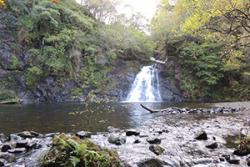Can we use eDNA as an ‘environmental magnifying-glass’?
An innovative idea submitted by Bangor University has been selected as one of eight projects selected within four “idea” areas to be funded by the Natural Environment Research Council’s (NERC) new “Highlight Topic” research funding stream.
Based on their research, the scientific community were invited to subject project areas which would place environmental science at the heart of the sustainable management of the planet.
“Environmental DNA: a tool for 21st century ecology”, the new idea suggested by Bangor University in collaboration with other academics and stakeholders, was among around 150 submissions. The successful project will assess how we can use new genetic techniques to measure biodiversity.
 Afon Prysor, Ceunant Llennyrch National Nature ReserveDr Simon Creer from the School of Biological Sciences explains:
Afon Prysor, Ceunant Llennyrch National Nature ReserveDr Simon Creer from the School of Biological Sciences explains:
“It may sound a little like science fiction, but we have recently discovered that ponds, lakes, streams and rivers carry hidden genetic signals of their inhabitants, as plants and creatures are constantly shedding cells into the environment that they live in. All living and dead cells contain the unique genetic code of individual species. We can access these genetic traces by filtering water from local rivers, followed by molecular genetic analysis in order to see what animals, plants and fungi are detectable. What is not clear however, is how the genetic signals relate to the real living community, especially in rivers and whether or not the signals, or “environmental DNA” can be used as a sort of “environmental magnifying glass” to understand how different land management types affect biodiversity in and around river catchments. Understanding this relationship is particularly important for assessing the health of lakes and rivers, our main sources of fresh drinking water.”
In order to find out more, Dr. Simon Creer and his team have been awarded the £1.25M Highlight Topic grant to work with The Centre for Ecology and Hydrology, Cardiff University, the University of Birmingham and collaborators throughout the world. The four year grant also includes a range of stakeholders including the UK Environment Agency, Natural Resources Wales and the Welsh Government.
Professor Angela Hatton, chair of NERC’s Science Board, said: “Highlight topics are designed to give the scientific community a greater role in identifying areas that need strategic research funding. This first group of projects will provide important knowledge to help society deal with problems including biodiversity loss, nanoparticle pollution and environmental change.”
Professor Graham Underwood, chairman of NERC’s Strategic Programme Advisory Group (SPAG) said: “The environmental science community responded magnificently to the challenges of the first highlight topics and these projects are well-aligned with the aims of SPAG. I’d like to thank all the applicants and those involved in the assessment that selected these excellent projects.”
Publication date: 2 November 2015
